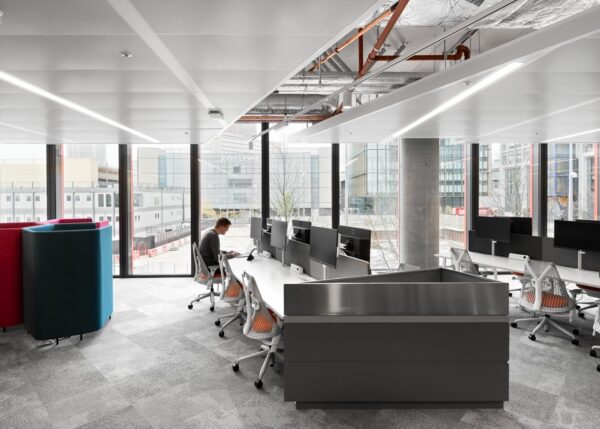The British Council for Offices Has Updated its Office Specification Guidance Early in Response to the Pandemic and UK Net Zero Targets
The British Council for Offices has released an early update to its flagship “Guide to Specification”, the industry “design bible” for offices, as it responds to developments in the sector driven by the pandemic and the UK’s net zero ambitions.
The update advises developers and designers on how to “future-proof” offices and create buildings that support changing working patterns and employee wellbeing, while reducing carbon emissions.
The Guide to Specification was last published in 2019 and is usually updated every five years, but since 2019 the sector has been subject to “unprecedented influences affecting building design”, the BCO says.
Standout recommendations include: an allocation of 10 square metres of space per person; increased levels of outdoor air supply and recommending smaller structural spans to open up the use of timber The BCO also now recommends a minimum sustainability target of BREEAM Excellent, up from Very Good, and and has introduced 5 Star NABERS UK target for new buildings, which measures energy use.
The specification also includes aspirational targets for: operational and embodied carbon use to meet net-zero-carbon goals; more efficient lighting installations; reduced power and cooling loads; higher performance facades; and more flexibility in the range of structural spans for office space.
BCO’s update on space allowed for each employee when designing a speculative office is now 10 square metres per person, up from the high occupancy density allowance of 8 square metres per person. That figure is now a “special use case for exceptional cases”.
The BCO says designing for 10 square metre per person occupancy density provides greater scope for the variety of workplace settings needed to support hybrid working. It also avoids the over-design of core services, improves floorplate efficiencies and minimises carbon emissions.
Changing technology means a greater use of low-powered tablets, laptops and smart phones, as well as the growth of cloud computing, that has led to a reduction in small power load allowances from 100W to 60W per person. The BCO says this in turn has cut back the heat generated in the office, which in turn reduces the cooling needed.
The BCO has updated its guidance to help support the office sector to achieve net zero carbon, it says.
It says many developers already target the BREEAM Outstanding rating for new offices and to “reflect the rapid progress in the sector in adopting more demanding sustainability targets”, the guide is moving its minimum BREEAM target rating from Very Good to Excellent. It is also introducing another building certification standard, NABERS UK, an energy performance rating relying on measured energy use. The update recommends targeting a 5-star NABERS UK rating for new building design.
Market trends have also fuelled a desire to create flexible, relatively column-free, open-plan offices, but the BCO says the structural solutions needed can be carbon intensive.
The 2023 update seeks to increase adoption of alternative structural materials such as timber by adding smaller 6 and 7.5m spans to the recommended range. It says this wider range provides designers with more options to minimise the embodied carbon of the structure. The selection of high-performance facades, lighting and building services systems should also be made, it says, with net zero targets in mind, prioritising energy efficiency.
Richard Kauntze, chief executive of the BCO, said the BCO Guide’s 2023 Update will drive the decarbonisation of the office sector, “enacting change to help the industry deliver on the UK’ s net zero by 2050 target”.
He said it also introduces more generous space standards and greater design flexibility to support wellbeing and sustainability as the office sector adapts to the world of hybrid work.
Neil Pennell, chair of the BCO’s technical affairs committee and head of design innovation and property solutions at Landsec, said: “The BCO’s new guidance reflects changes in design thinking since 2019 driven by net-zero Carbon targets, increased hybrid working post COVID-19, changes in regulations and improvements in equipment performance.
“There is a clear imperative to adopt a whole-building approach to decarbonise the sector which needs to start with the design and specification of new and refurbished office space. Developed in collaboration with the UK’s leading experts, the BCO Guide to Specification gives clear advice on how operational and embodied carbon can be reduced without compromising the need to provide flexible office space that meets the needs of occupiers and helps them to conduct their business in safe, healthy, comfortable and productive workspaces. ”
The British Council for Offices is the UK’s leading member organisation representing the interests of people who occupy, design, build, own or manage offices in the UK.

